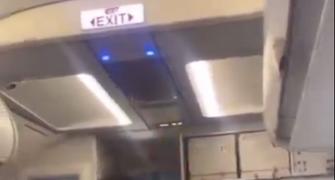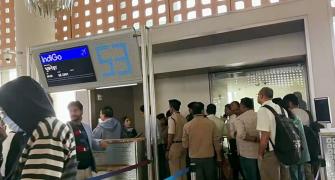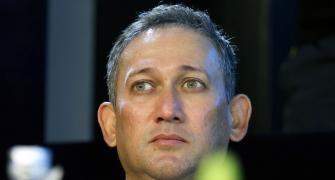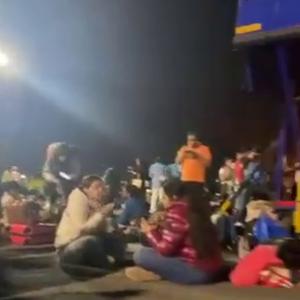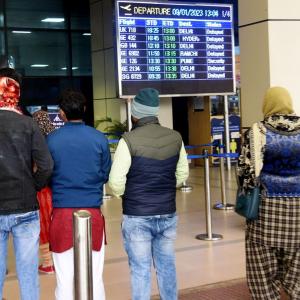The phenomenon of fog is largely Delhi-centric.
Airlines may think that we only have conditions of extreme fog on a few days every year, and spending a pilot's time and the airline's money on training can add up to its expenses.'
'So, they may prefer holding it for a few days.'

Time-intensive training and a shortage of pilots certified to operate in foggy conditions may be causing flight disruptions during the winter season in Delhi, aviation experts believe.
To train pilots for operating in such conditions, airlines must secure flight simulator slots for CAT III training well in advance, given that these systems are typically booked for pilots' routine licence renewal training.
"CAT III training is a time-consuming process for airlines as simulators in the country are already booked for regular training. The bookings for these systems are not instant as there are challenges with the availability of simulators," Ameya Joshi, an aviation analyst and founder of the aviation blog 'Network Thoughts' told Business Standard.
Pilots need to undergo training programmes, such as CAT III, which refers to a category of Instrument Landing System (ILS), to guide aircraft during their descent and landing in foggy and low-visibility conditions.
Also, only a few pilots could train on these simulators during the pandemic as the enclosed spaces carried a high risk of transmission, exacerbating the challenge with simulator availability today.
"After the pandemic subsided and flight operations resumed, there was a lack of simulator availability as most of them were booked for pilots who couldn't undergo mandatory training for licence renewal. Now, the CAT III training that happens on these simulators got naturally stretched," Joshi added.
A shortage of pilots in the industry also may limit airlines from deploying all their pilots to such training procedures.
"There is a general shortage of pilots in the industry today. Moreover, the ones who are qualified to operate in foggy conditions are a smaller number," said Captain S S Panesar, a former pilot and ex-director of Flight Safety and Training at Indian Airlines.
"An airline will have to take a pilot off-duty during his or her training, which may have an impact on its commercial operations as a lesser number of personnel are deployed for ops.
"Airlines would not prefer to do it," Captain Panesar added.
He explained that a pilot-in-command and a co-pilot should have a minimum flying experience of 2,500 and 500 hours, which is required for the CAT II or CAT III training programme.
"After the completion of CAT II simulator training, which includes sessions of a minimum of three hours, pilots are eligible to undergo a two-hour session consisting of ILS CAT-III approaches.
"This is followed by an actual landing in CAT III-type weather, only after which the pilot is CAT III certified," he added.
In CAT III B, the visibility for landing and take-off for an aircraft ranges from 50 to 174 metres, whereas for CAT III A, the visibility ranges between 175 and 299 metres.
These training programmes can cost around Rs 500,000 per pilot for an airline, an industry source said, requesting anonymity.

"Apart from the time required to train pilots, and the time they're off duty during training, it may get expensive for airlines to train all their pilots for fog-like conditions. Plus, it's a small duration during an entire year when fog sets in, and the occurrence is limited to major northern airports like Delhi only," the person added.
Echoing a similar view, Joshi said the phenomenon of fog is largely Delhi-centric. "Airlines may think that we only have conditions of extreme fog on a few days every year, and spending a pilot's time and the airline's money on training can add up to its expenses. So, they may prefer holding it for a few days," he said.
Delhi airport has two CAT IIIB-compliant runways, one currently under maintenance.
"One can expect for the runway to open up in the first week of January. That way, Delhi will again have two CAT III runways instead of just one improving the condition at the airport," the airport source quoted above said.
Hundreds of flights faced delays between December 24 and 28, out of which 58 had to be diverted due to low visibility conditions at Delhi airport. A similar situatiion occurred on Sunday and Monday.
Of these flights, around 50 were diverted because pilots were not trained to operate in conditions of dense fog, an airport source said.
When responses were sought from the airlines on CAT III compliant pilots in airlines, only IndiGo responded.
"IndiGo has sufficient CAT III qualified pilots. These pilots have been rostered for optimal operations during the winter season.
'As India's largest airline, IndiGo operates more than 2,000 daily flights. In that context, the number of diversion cases represents a very small fraction,' the airline stated.
'We are putting in every effort to minimise inconvenience to passengers in the event of flight disruption due to bad weather,' the airline added.
However, none of the airlines shared the number of CAT III certified pilots they currently have.
Joshi explains that aircraft might have to hold before landing at such airports due to decreased air traffic movement.
"The number of take-offs and landings naturally reduces when visibility decreases. In such a scenario, when there are multiple flights waiting to land, there will be some holding in the skies by aircraft.
"So, even if the pilot and the runway are CAT III compliant, the pilot may have to divert once pilots realise they can no longer hold due to fuel constraints," he added.
Passengers are at the receiving end of delays that happen due to such issues.
"On my flight back to Delhi," said a passenger on a Goa-Delhi flight, "after the pilot had announced and asked the cabin crew to prepare for descent, the flight was hovering in the skies for nearly 20 minutes, presumably due to thick fog. This delayed our landing by 30 minutes."

Feature Presentation: Ashish Narsale/Rediff.com


